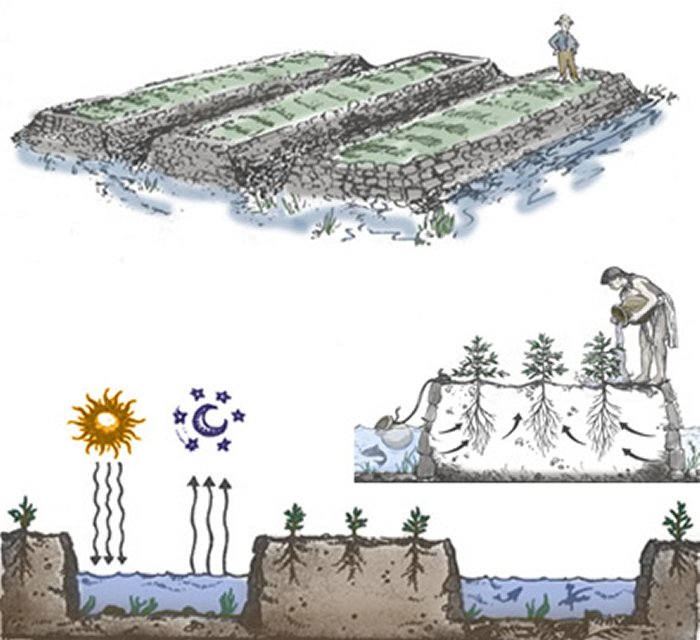Waru Waru – Ancient Andean Irrigation System Brought Back To Life
Ellen Lloyd - AncientPages.com - Not all knowledge of our ancestors is lost forever and there is still much to be learned from ancient people and their methods to handle climate changes, for example. Using wisdom from the past, modern scientists can help poor communities to handle water related problems.
Ancient Farming Techniques Can Help Our Modern World
Thousands of years ago, our ancestors came up with efficient farming techniques that modern scientists are now investigating to mitigate climate change. One of the most interesting technologies of ancient time are underground irrigation canals known as “qanats”, developed by people in Persia about 3,000 years ago. The qanats transported water from a water wells to surface for irrigation and drinking as well and they could do it over long distances.
The Hohokam people were 'Masters of the Desert’. Their extensive irrigation canals served as the foundation of the modern canals used to irrigate crops in the valleys along the Salt and Gila rivers. The Aztecs built so-called chinampas to improve their agriculture. These were small, artificial islands created on a freshwater lake. The chinampas resembled floating gardens.
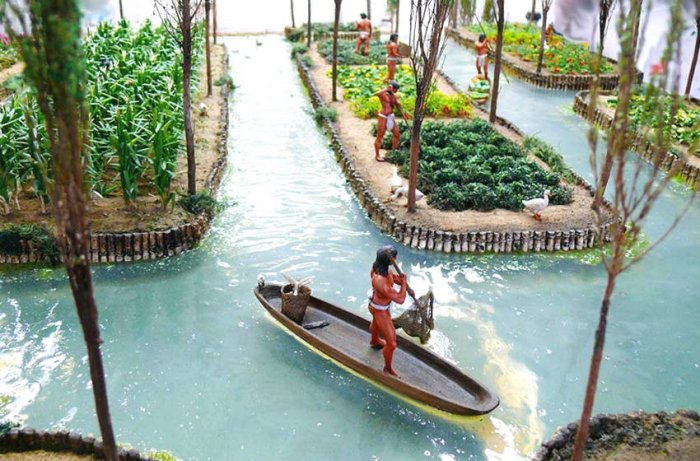
Chinampas: Artificial Islands Created By The Aztecs To Improve Agriculture - Image credit: Ez Gro Garden
Chinampas were used throughout the Valley of Mexico around the lake bed and were without doubt one of the reasons why Aztec’s farming became famous.
Knowledge Of Waru Waru Is Not Lost
Before the rise of the Inca Empire, Andean people developed an agricultural technique called Waru Waru. This technology, based on modification of the soil surface to facilitate water movement and storage helped people to cope with floods and droughts.
Combining raised beds with irrigation channels to prevent damage by soil erosion during floods, was an inexpensive way to improve crop yields and ease the punishing effects of farming at 12,500 feet above sea level on the Andean plains.
Image credit: Ez Gro Garden
Also known as suqakollos, the Waru Waru resembles an ornate garden maze from above. It’s a cleverly designed patterned system of raised cropland and water-filled trenches.
Around Lake Titicaca, as many as 250,000 acres show traces of Waru Warus. This suggests ancient inhabitants of the altiplano were successfully using this agriculture method to tackle the considerable environmental constraints of farming the area.
When more technically advanced irrigation technologies were discovered, Waru Waru was abandoned. However, in more recent years, the Waru Waru technology has been brought back to life in Bolivia and Peru. Scientists discovered that Waru Waru technology not only worked, but it tripled crop production.
See also:
Qanats: Ancient 3,000-Year-Old Underground Irrigation Canals Invented By People Of Persia
In 1981, Clark Erickson, of the University of Illinois, recognized the archaeological significance of Waru Waru. Erickson wondered whether this ancient system might not serve modern farmers and began to rebuild some of the raised fields. Using traditional Andean tools, local farmers planted an experimental field with potatoes, quinoa and canihua. Private development organizations and the Peruvian government rushed in to aid farmers.
According to Alipio Canahua, a program director for the international humanitarian agency CARE, “there was Waru Waru fever to reconstruct ancient technology back then.”
Locals in Cutini Capilla, an Aymara community on the western shore of Lake Titicaca between Puno and the ruins of the Tiwanaku capital said the Waru Warus have helped them to make the land useful again.
Waru Waru technology. Credit: irrigaciondelperu
Alipio Canahua, an agronomist working with the Food and Agriculture Organisation (FAO), says that the ancient agricultural system, which could date back 3,000 years, actually creates its own microclimate.
“It captures water when there are droughts and drains away water when there’s too much rain, meaning that it irrigates the crops all year round,” he says. “When it comes to temperature, we’ve measured a rise of three degrees centigrade in the immediate environment around it – this can save a significant percentage of the crops from being killed in frosts.”
Credit: Blog de Historia General del Perú
The ancient Waru Waru technology has been brought back to life, but whether it survives depends on investments and financial support from the governments.
It is also impossible to make the suqakollos as big as pre-Hispanic people did because roads and boundaries between communal lands, have limited the space available.
Scientists think that the ancient Waru Waru technology could be used in conjunction with other ancient techniques such as interconnected irrigation lakes called "qochas" and the Inca-built terraces known as "andenes" for farming the steep Andean slopes.
Written by Ellen Lloyd – AncientPages.com
Copyright © AncientPages.com All rights reserved. This material may not be published, broadcast, rewritten or redistributed in whole or part without the express written permission of AncientPages.com
More From Ancient Pages
-
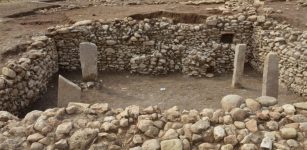 Temples At Boncuklu Tarla Are Older Than Göbekli Tepe And Re-Write Ancient History
Archaeology | Dec 10, 2019
Temples At Boncuklu Tarla Are Older Than Göbekli Tepe And Re-Write Ancient History
Archaeology | Dec 10, 2019 -
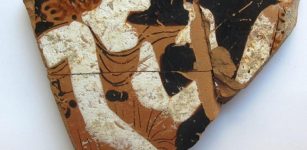 2,700-Year-Old Ancient City Of Limnai On Turkey’s West Coast – Discovered
Archaeology | Nov 22, 2018
2,700-Year-Old Ancient City Of Limnai On Turkey’s West Coast – Discovered
Archaeology | Nov 22, 2018 -
 The Magnificent Yule Goat In Gävle, Sweden Has Finally Arrived
Ancient Traditions And Customs | Dec 1, 2020
The Magnificent Yule Goat In Gävle, Sweden Has Finally Arrived
Ancient Traditions And Customs | Dec 1, 2020 -
 Underwater Artifacts Shed New Light On Battle Of The Egadi Islands Between Romans And Carthage
Archaeology | Dec 16, 2020
Underwater Artifacts Shed New Light On Battle Of The Egadi Islands Between Romans And Carthage
Archaeology | Dec 16, 2020 -
 How Did A Rare 2,000-Year-Old Gem Seal Depicting God Apollo End Up In The City Of David?
Archaeology | Nov 5, 2020
How Did A Rare 2,000-Year-Old Gem Seal Depicting God Apollo End Up In The City Of David?
Archaeology | Nov 5, 2020 -
 Beethoven’s Genome Offers Clues To Composer’s Health And Family History
DNA | Mar 27, 2023
Beethoven’s Genome Offers Clues To Composer’s Health And Family History
DNA | Mar 27, 2023 -
 Secrets Of Benjamin Franklin’s Paper Money Deciphered By Scientists
Archaeology | Jul 18, 2023
Secrets Of Benjamin Franklin’s Paper Money Deciphered By Scientists
Archaeology | Jul 18, 2023 -
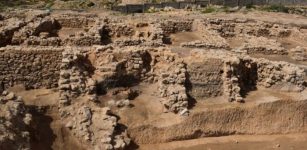 Ancient Greco-Roman Amphora Workshop Discovered In Alexandria, Egypt
Archaeology | Apr 17, 2022
Ancient Greco-Roman Amphora Workshop Discovered In Alexandria, Egypt
Archaeology | Apr 17, 2022 -
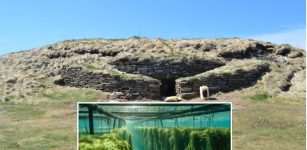 Ancient Europeans Ate Seaweed And Freshwater Plants – Evidence Found
Archaeology | Oct 17, 2023
Ancient Europeans Ate Seaweed And Freshwater Plants – Evidence Found
Archaeology | Oct 17, 2023 -
 On This Day In History: Sverre Sigurdsson Became King Of Norway – On June 29, 1194
News | Jun 29, 2016
On This Day In History: Sverre Sigurdsson Became King Of Norway – On June 29, 1194
News | Jun 29, 2016 -
 Does Palenque Mask Depict Mayan Ruler Pakal? New Discovery At Palenque
Archaeology | Aug 27, 2018
Does Palenque Mask Depict Mayan Ruler Pakal? New Discovery At Palenque
Archaeology | Aug 27, 2018 -
 Carian Princess’ Tomb, Golden Artifacts – Now On Display In Renovated Hall Of Bodrum Castle
Artifacts | Aug 27, 2020
Carian Princess’ Tomb, Golden Artifacts – Now On Display In Renovated Hall Of Bodrum Castle
Artifacts | Aug 27, 2020 -
 Persephone: Greek Goddess Of The Coming Spring And Lady Of The Land Of The Dead
Featured Stories | Jun 26, 2021
Persephone: Greek Goddess Of The Coming Spring And Lady Of The Land Of The Dead
Featured Stories | Jun 26, 2021 -
 Young Warrior’s Grave Dated To A Sixth Century Unearthed At Langobard Necropolis In Czech Republic
Archaeology | Jul 5, 2022
Young Warrior’s Grave Dated To A Sixth Century Unearthed At Langobard Necropolis In Czech Republic
Archaeology | Jul 5, 2022 -
 Intact 2,700-Year-Old Pacopampa Tomb Found in Northern Peru
Civilizations | Sep 17, 2015
Intact 2,700-Year-Old Pacopampa Tomb Found in Northern Peru
Civilizations | Sep 17, 2015 -
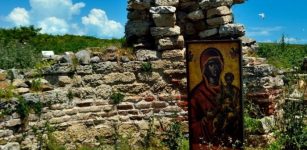 A 1,500-Year-Old Holy Well Probably With Healing Water – Discovered In Bulgaria
Archaeology | Nov 25, 2020
A 1,500-Year-Old Holy Well Probably With Healing Water – Discovered In Bulgaria
Archaeology | Nov 25, 2020 -
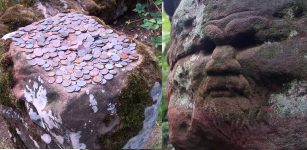 Dunino Den: Mysterious And Sacred Ancient Site In Scotland With Enigmatic Rock Faces And Symbols
Featured Stories | Jan 6, 2017
Dunino Den: Mysterious And Sacred Ancient Site In Scotland With Enigmatic Rock Faces And Symbols
Featured Stories | Jan 6, 2017 -
 On This Day In History: The Battle of Mortimer’s Cross – On Feb 2, 1461
News | Feb 2, 2017
On This Day In History: The Battle of Mortimer’s Cross – On Feb 2, 1461
News | Feb 2, 2017 -
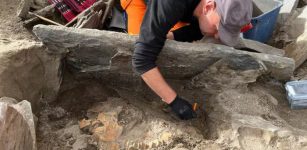 ‘Sensational’ Discovery Of Large Untouched 4,000-Year-Old Grave In Norway
Archaeology | Nov 10, 2023
‘Sensational’ Discovery Of Large Untouched 4,000-Year-Old Grave In Norway
Archaeology | Nov 10, 2023 -
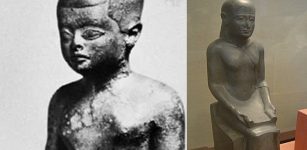 Imhotep: Ancient Genius And Architect Of The Sakkara Pyramid
Featured Stories | Mar 7, 2016
Imhotep: Ancient Genius And Architect Of The Sakkara Pyramid
Featured Stories | Mar 7, 2016

